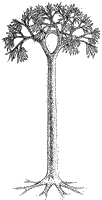    |
||||||
 Fossil Flora Fossil FloraSome of the trees found at Joggins were probably over 30 m (98 ft) high. Lycopods, or scale trees, had scaly-looking bark that is often found fossilised. Their roots, with small round holes where the rootlets were once attached, are also common fossils, called Stigmaria. Lepidodendron sp. and Sigillaria sp. are two types of lycopods.
There are no Calamites or lycopods today, but smaller relatives have survived: the little horsetail Equisetum sp. (also called scouring rush) is a descendent of Calamites, and club mosses are modern-day lycopods.
Fossilised Sphenophyllum sp. have also been found. This plant, whose leaves radiate out from the stem at uniform intervals, was probably a climbing vine.
|

 The
undergrowth seems to have been mostly plants called seed ferns, whose leaves look very
much like the leaves of modern ferns.
The
undergrowth seems to have been mostly plants called seed ferns, whose leaves look very
much like the leaves of modern ferns.